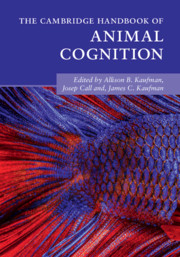Book contents
- The Cambridge Handbook of Animal Cognition
- The Cambridge Handbook of Animal Cognition
- Copyright page
- Dedication
- Contents
- Figures, Tables, and Boxes
- Contributors
- Acknowledgments
- Introduction
- Part I Communication and Language
- 1 Animal Communication Overview
- 2 Communication in Ant Societies
- 3 Symbolic Communication in the Grey Parrot
- 4 Communication in Dogs and Wolves
- 5 Semantic Communication in Primates
- Part II Memory and Recall
- Part III Social Cognition
- Part IV Social Learning and Teaching
- Part V Numerical and Quantitative Abilities
- Part VI Innovation and Problem-Solving
- Index
- References
3 - Symbolic Communication in the Grey Parrot
from Part I - Communication and Language
Published online by Cambridge University Press: 01 July 2021
- The Cambridge Handbook of Animal Cognition
- The Cambridge Handbook of Animal Cognition
- Copyright page
- Dedication
- Contents
- Figures, Tables, and Boxes
- Contributors
- Acknowledgments
- Introduction
- Part I Communication and Language
- 1 Animal Communication Overview
- 2 Communication in Ant Societies
- 3 Symbolic Communication in the Grey Parrot
- 4 Communication in Dogs and Wolves
- 5 Semantic Communication in Primates
- Part II Memory and Recall
- Part III Social Cognition
- Part IV Social Learning and Teaching
- Part V Numerical and Quantitative Abilities
- Part VI Innovation and Problem-Solving
- Index
- References
Summary
Decades ago, Premack (1978) hypothesized that nonhuman subjects that could acquire symbolic representation and communication would process information differently from those that could not. He argued that such processing would enable such subjects to perform more complicated cognitive tasks than those without such processing, and at levels comparable to those of young children, if not adult humans. Finally, he claimed that such acquisition and processing would likely be limited to nonhuman primates. Studies over the past 40 years, involving Grey parrots (Psittacus erithacus), have shown that Premack’s basic premise concerning the effects of symbolic representation was correct, but that the acquisition and use of symbolic representation to solve complex problems goes well beyond the primate line. I document how acquisition of symbolic representation and communication has enabled these parrots to perform at levels beyond those of some nonhuman primates and at levels equivalent to four-to- seven-year-old children.
Keywords
- Type
- Chapter
- Information
- The Cambridge Handbook of Animal Cognition , pp. 56 - 73Publisher: Cambridge University PressPrint publication year: 2021



